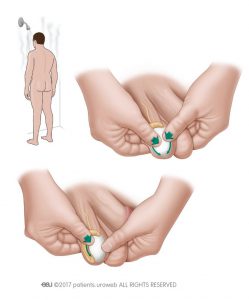Testicular Self Examination (TSE)
TSE can identify testicular problems including cancer. It can be performed in a bath or shower when the scrotum is warm and relaxed. Each testicle should be checked separately using both hands (see diagram). The thumb and fingers can be used to feel the surface of each testicle for any lumps. The epididymis or sperm collecting tube can be felt behind each testicle and will feel soft and spongy.
It is important to understand that most abnormalities men may find when performing TSE will not be testicular cancer. There are non-cancerous conditions which are more common and can affect different parts of the testicles. A small painless lump within the body of the testicle itself, is more suspicious. Any abnormality needs to be checked by a doctor but most abnormalities will not be cancer.
Resources





